当前位置:网站首页>What is AVL tree?
What is AVL tree?
2022-07-06 23:54:00 【Building Zzzz】

Catalog
One . What is? AVL Trees
To know AVL Before tree, let's know what a binary search tree is :
1. Binary search tree
Binary search tree Also known as binary sort tree , Binary search tree satisfies All left child nodes are smaller than the value of their root node , All right child nodes are greater than the value of their root node , Every subtree on the binary search tree is a binary search tree , Therefore, the binary search tree can obtain an ordered sequence by traversing the middle order ( From small to large );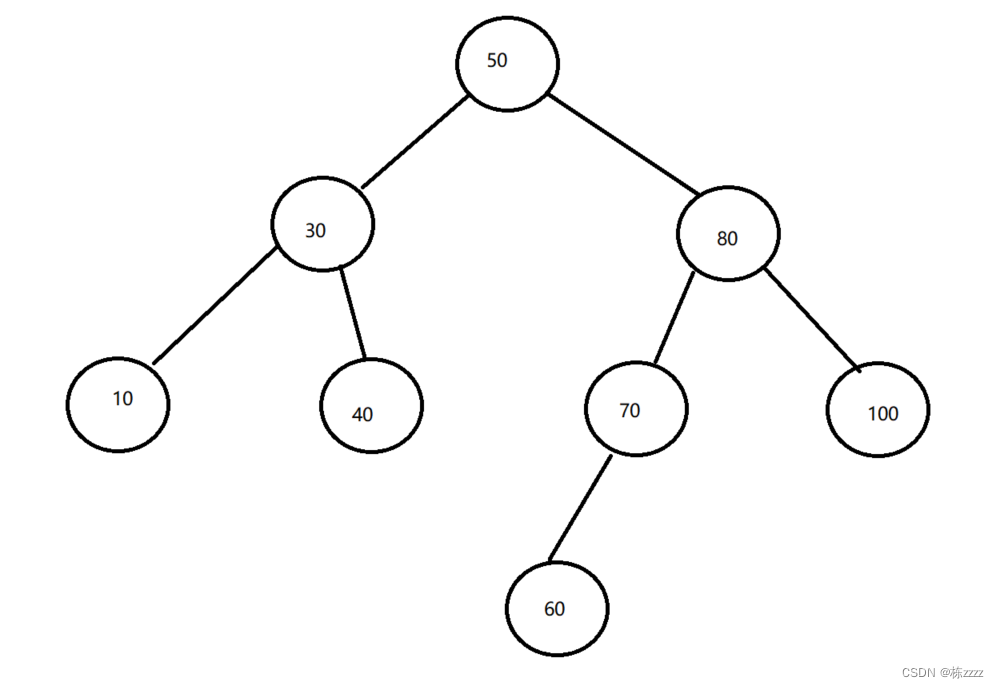
A tree like this is a binary search tree ;
2. Why introduced AVL Trees
Binary search tree looks beautiful , But it has some defects . For binary search tree , It is related to search , Whether it is to find or delete , You need to find it first , That is to traverse the whole tree , And yes n A binary search tree of nodes , If the probability of finding each element is equal , Then the average search length of the binary search tree is a function of the depth of the node in the binary search tree , That is, the deeper the node , The more times you compare . The optimal In the case of : The binary search tree is a complete binary tree , The average number of comparisons is : l o g 2 n log_2{n} log2n, But if the binary search tree degenerates into a single branch tree , The average number of comparisons is :n/2, Namely The worst The situation of the 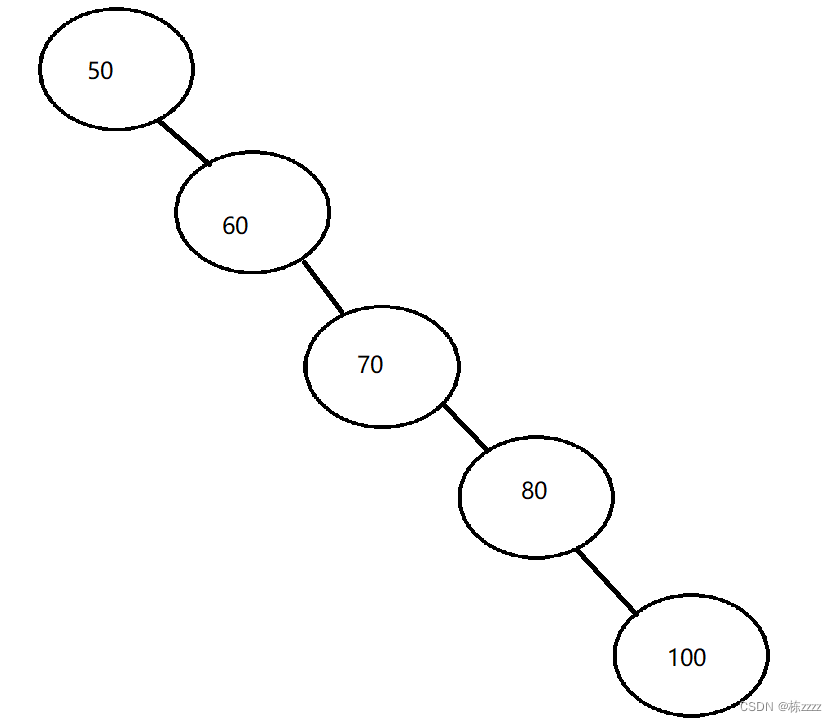
This is equivalent to the search of a sequential table , In this way, the advantage of binary search tree disappears completely , So it introduces AVL Trees !
3. What is? AVL Trees
AVL Tree is also called self balanced binary search tree , Is a highly balanced binary search tree , It is optimized on the basis of binary search tree , After inserting a new node into the binary search tree , Ensure that the absolute value of the height difference between the left and right subtrees of each node does not exceed 1( You need to adjust the nodes in the tree ), That is to lower the height of the tree , This will reduce the average search length , therefore AVL The tree is satisfied Its left and right subtrees are AVL Trees , The difference between the height of the left and right subtrees ( It's called equilibrium factor ) The absolute value of is not more than 1(-1/0/1), This is it. AVL The advantage of trees , So if a binary search tree is highly balanced , It is AVL Trees . If it has n Nodes , Its height can be maintained at , Search time complexity O( l o g 2 n log_2{n} log2n)!!!
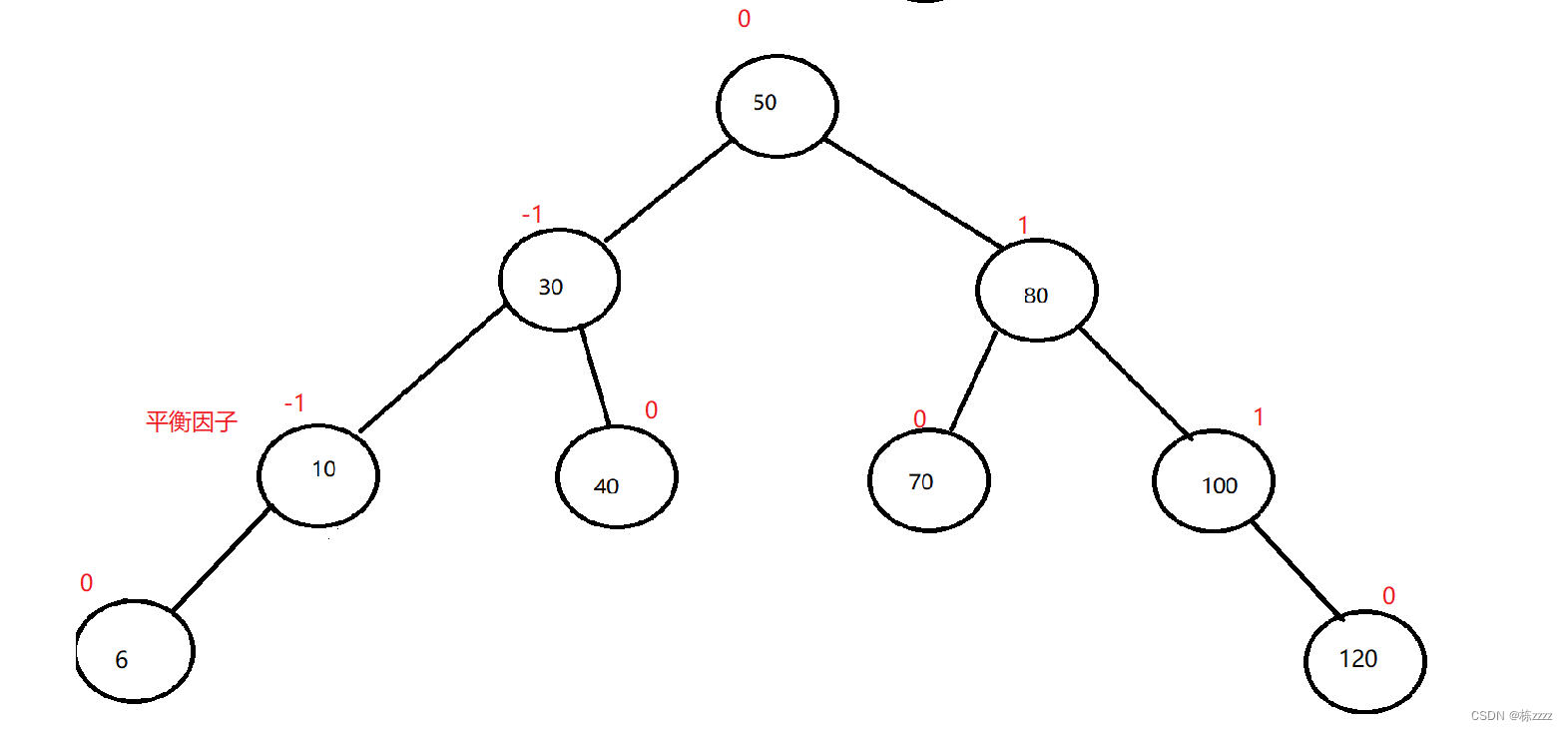
Balance factor = The height of the right subtree - The height of the left subtree 
Two . Build your own AVL Trees
The structure here is similar to that of binary search tree , But if you insert elements here, you need to consider the balance factor , Because you must ensure that the tree is still a tree after inserting elements AVL Trees , Relevant adjustments are needed , Let's not introduce more here , Let's talk about it in detail , First, construct a simple AVL Trees :
public class AVLTree {
static class TreeNode{
// Inner class , Express AVL Each node of the tree
//val value
public int val;
// Left child's quote
public TreeNode left;
// Right child's quote
public TreeNode right;
// Reference of parent node
public TreeNode parent;
// Balance factor ( Every node has )
public int bf;
public TreeNode(int val){
this.val = val;
}
}
// The root node
public TreeNode root;
public boolean insert(int val){
}
}
Such a simple tree AVL The tree is constructed , Now let's write AVL Insertion of trees !
3、 ... and .AVL Insertion and deletion of trees
1. Insert
First, insert the node , Like a binary search tree , First, just look at the location , Do not pay attention to the balance factor 
This is the node to be inserted :
TreeNode node = new TreeNode(val);
if(root == null){
// No root node , What you want to insert is the root node
root = node;
return true;
}
// Record the parent node of each node
TreeNode parent = null;
// Generation node to be moved
TreeNode cur = root;
// according to val The value of and root Compare to determine where the node should be inserted
while (cur != null){
if(cur.val > val){
// Greater than proves that this node should be in the left subtree
parent = cur;
cur = cur.left;
}else if(cur.val < val){
// Greater than proves that this node should be in the right subtree
parent = cur;
cur = cur.right;
}else {
// You cannot have nodes with the same value
return false;
}
}
// here cur It's empty , You need to find the corresponding location
if(parent.val > val){
parent.left = node;
}else{
parent.right = node;
}
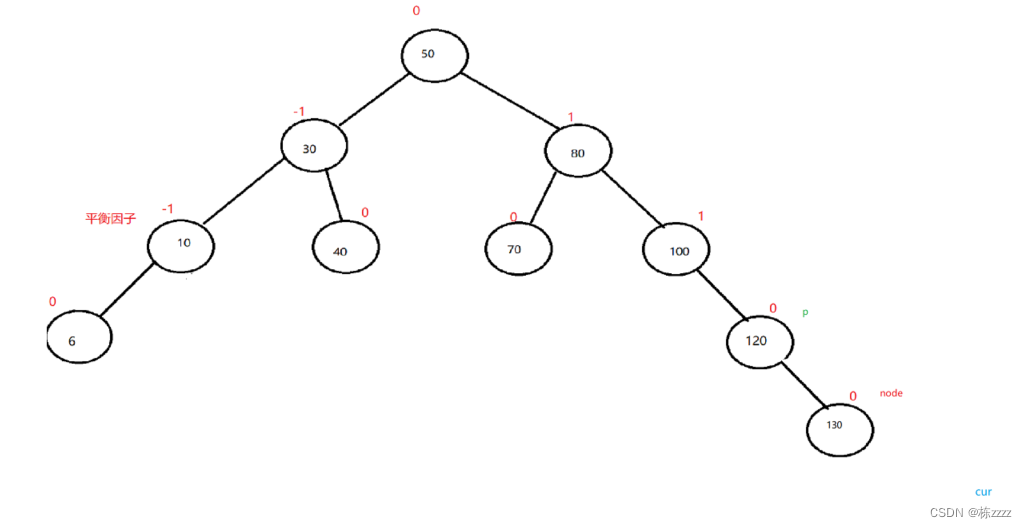
At this point, the node has been inserted , At this point, we need to look at the balance factor of each node
// At this time, it is necessary to adjust the balance factor of the tree , Make sure the tree is highly balanced
// Then go back and write
node.parent = parent;
cur = node;
// When the parent node always exists , It means that you need to continue to adjust if you do not adjust to the root node
while(parent != null){
if(cur == parent.right){
// Add one to the height of the right tree on the right , therefore bf+1
parent.bf++;
}else{
// To the left , Add one to the height of the left tree , therefore bf-1
parent.bf--;
}
// Here is the judgment , If the balance factor of the parent node at this time is 0 了 , Then there is no need to go up , Because the above is balanced
if(parent.bf == 0){
return true;
}else if(parent.bf == -1 || parent.bf == 1){
// At this time, the balance factor of the parent node is 1、-1
// This indicates that the current tree is balanced , But it doesn't mean that the whole tree is balanced , Therefore, we need to continue to go up
cur = parent;
parent = cur.parent;
}else{
// At this time, the balance factor of the parent node is 2、-2
if(parent.bf == 2){
// At this time, the right tree is tall You need to lower the height of the right tree
if(cur.bf == 1){
// Left spin
rotateLeft(parent);
}else{
// Right left double rotation
rotateRL(parent);
}
}else{
// At this time, the left tree is tall , You need to lower the height of the left tree
if(cur.bf == 1){
// Double left and right
rotateLR(parent);
}else{
// Right single spin
rotateRight(parent);
}
}
}
}
This is the current problem :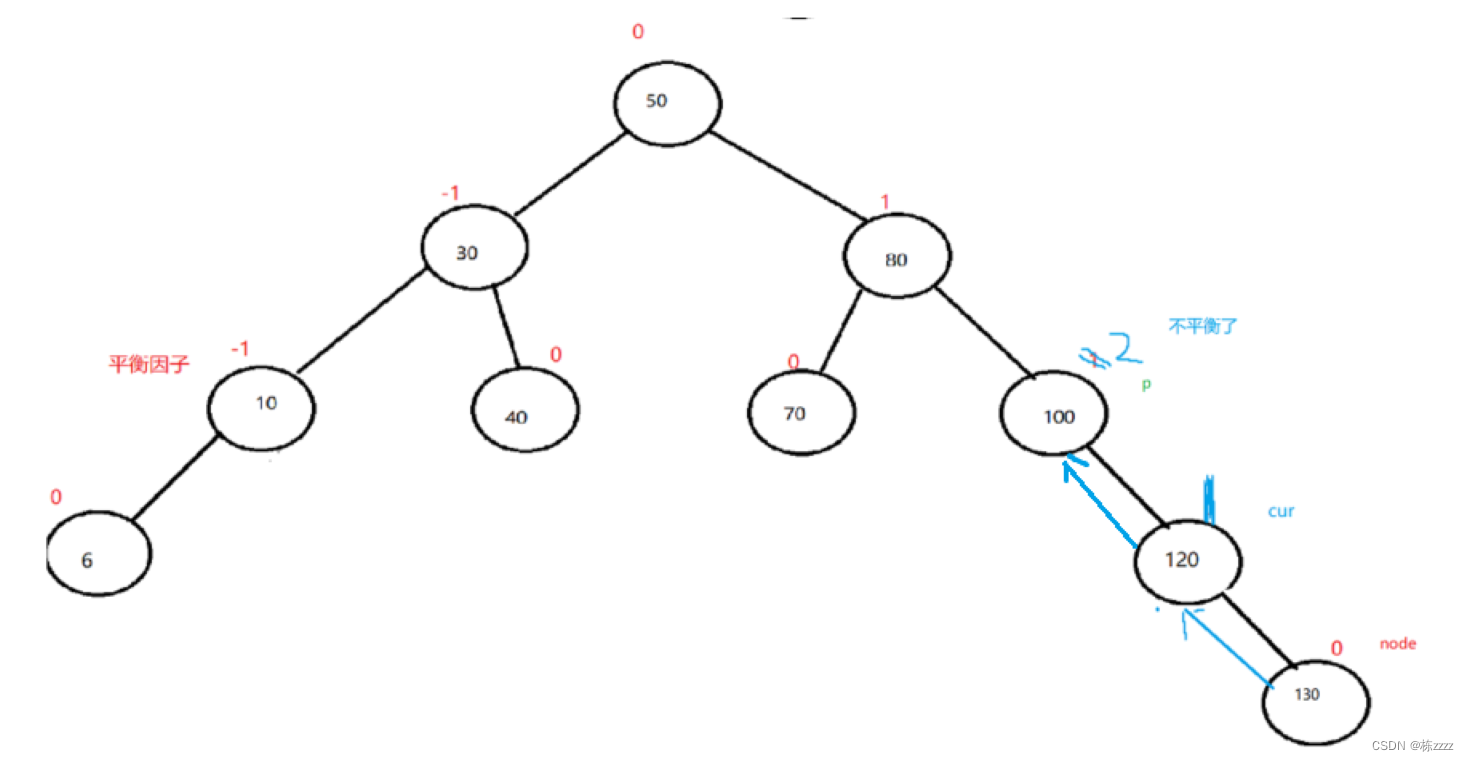
First, let's discuss some situations that will occur when adjusting the balance factor , Let's have a look at each of them :
First, the balance factor is adjusted to 0 了 , Then there is no need to go up , Because the above is balanced , Of the current parent node The equilibrium factor is 0 It means that the inserted element only affects this tree , The above has no effect , So it is 0 Then it's over 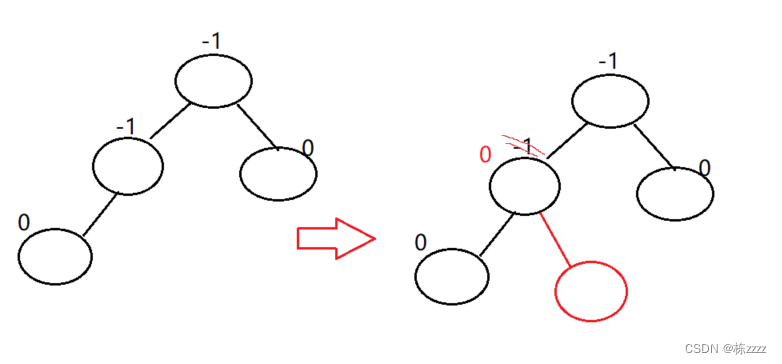
So it is 0 It means that the current is over , There's no need to go up , Others become 0 The situation is the same here is not detailed painting
And if it is 1 perhaps -1 Words , Indicates that the current tree is balanced , But it doesn't mean that the whole tree is balanced , So we need to go up again ;
And if it is 2 perhaps -2 Words , There are four situations , Let's take a look at them separately :
1.1. Right single spin
here Zuo Shugao , You need to lower the height of the left tree , That is right-handed (parent.bf = -2,cur.bf = -1):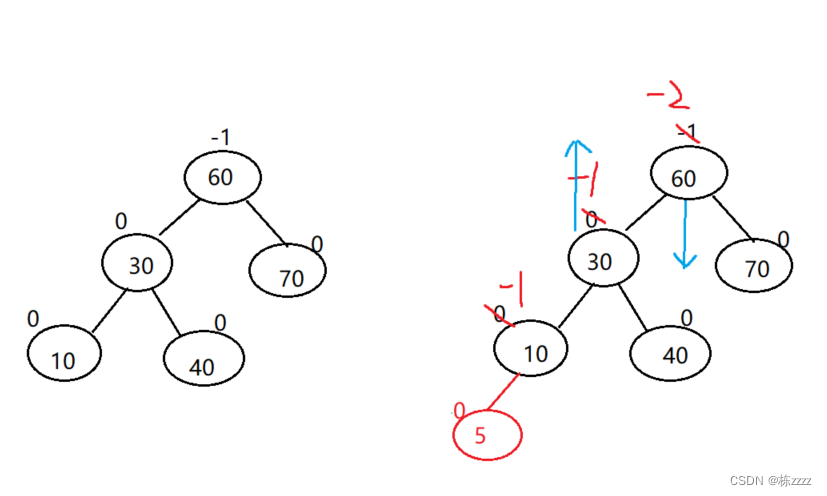
That is, the following effects :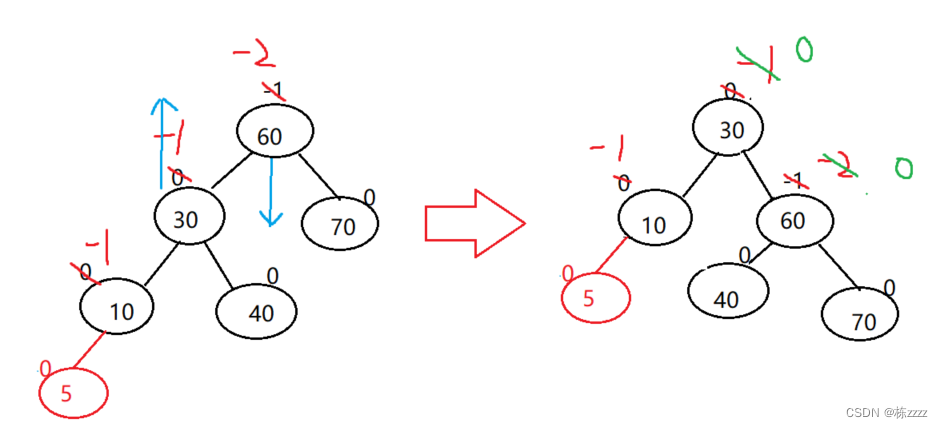
This is the adjustment process :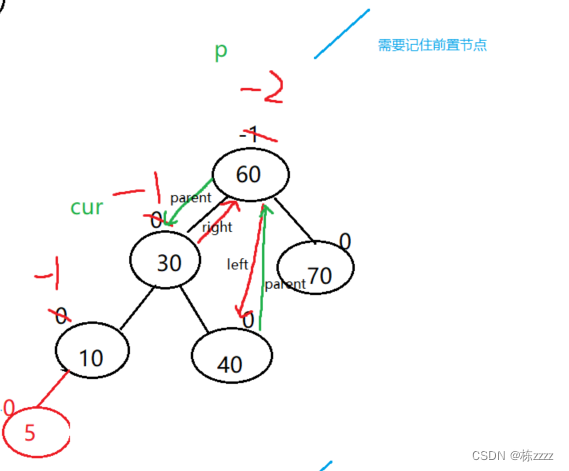
Write the code below :
private void rotateRight(TreeNode parent){
// Right single spin
// here parent The equilibrium factor of -2,cur The equilibrium factor of -1
// Need record parent The root node
TreeNode pParent = parent.parent;
TreeNode cur = parent.left;
// Record cur The right of the node
TreeNode curR = cur.right;
// If cur There is a right node that needs to be assigned to parent The left node , But if you don't have it, you don't need to give it
if(curR != null){
parent.left = curR;
curR.parent = parent;
}
// And then cur The right child of is changed to parent
cur.right = parent;
parent.parent = cur;
// Check whether the current root node , It's not the root node, but the left subtree , Or right subtree
if(pParent != null){
// Change the previous direction
cur.parent = pParent;
if(parent == pParent.right){
pParent.right = cur;
}else{
pParent.left = cur;
}
}else{
// here parent Namely root, Because there is no root node
cur = root;
root.parent = null;
}
// Finally, remember to modify the balance factor
parent.bf = 0;
cur.bf = 0;
}
Such a “ Simple ” The right single spin of is over ~
1.2. Left spin
This is the initial situation
here Right tree height , You need to lower the height of the right tree , That is left-handed (parent.bf = 2,cur.bf = 1):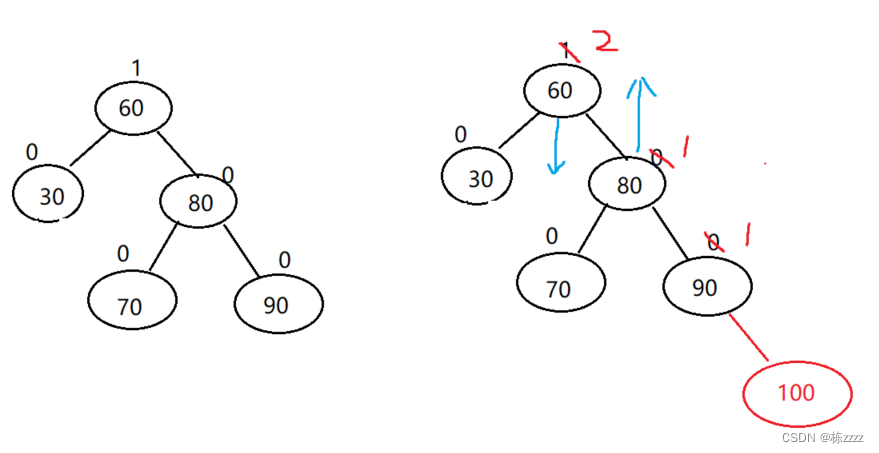
That is, the following effects :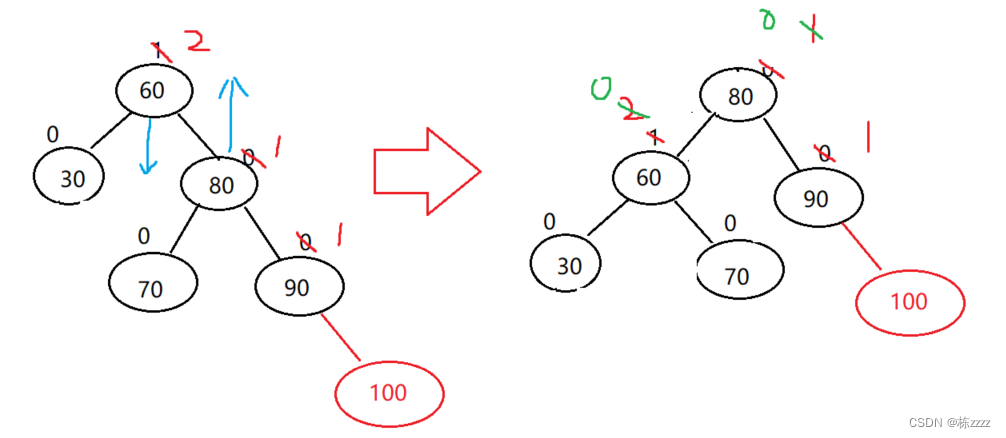
This is the adjustment process :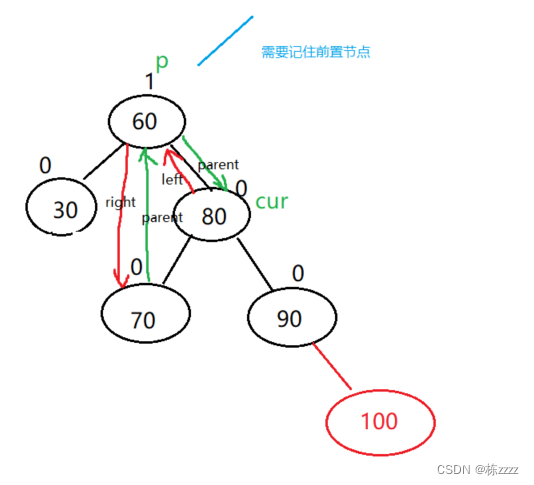
The code is as follows :
private void rotateLeft(TreeNode parent){
// Left spin
// here parent The equilibrium factor is 2,cur The equilibrium factor of 1
// Parent node needs to be recorded
TreeNode pParent = parent.parent;
TreeNode cur = parent.right;
// Record cur The left node
TreeNode curL = cur.left;
// Judge whether the left node is empty , If it is empty, there is no need to care , If it is not empty, you need to parent The right node points to it , And its parent node is parent
if(curL != null){
// Change direction
parent.right = curL;
curL.parent = parent;
}
// change cur The direction of
cur.left = parent;
parent.parent = cur;
// Determine if the pParent Not empty , It means parent No root, It depends on whether it is a left child or a right child
if(pParent != null){
cur.parent = pParent;
if(parent == pParent.right){
pParent.right = cur;
}else{
pParent.left = cur;
}
}else{
// Root node
cur = root;
root.parent = null;
}
cur.bf = 0;
parent.bf = 0;
}
Such a “ Simple ” The left single spin of is over ~
1.3. Double left and right
At this time, the left tree is tall , You need to lower the height of the left tree ,(parent.bf = -2,cur.bf = 1):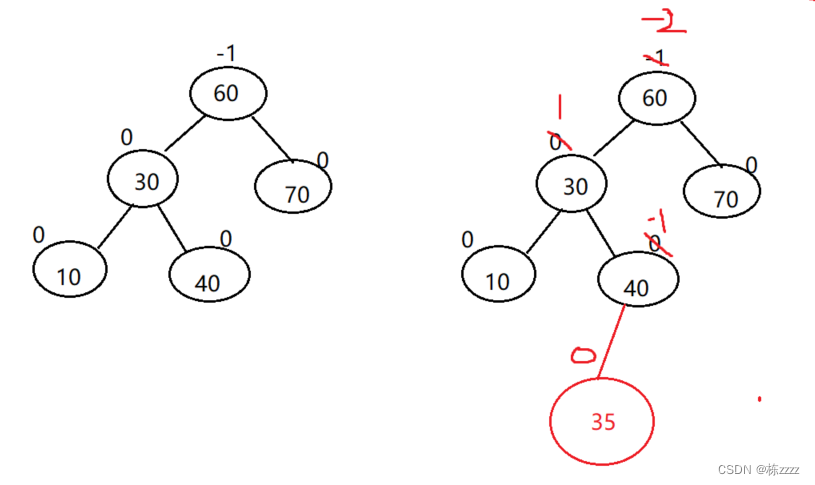
At this time, it is impossible to complete by single rotation , Need to pass through Two rotations To complete :
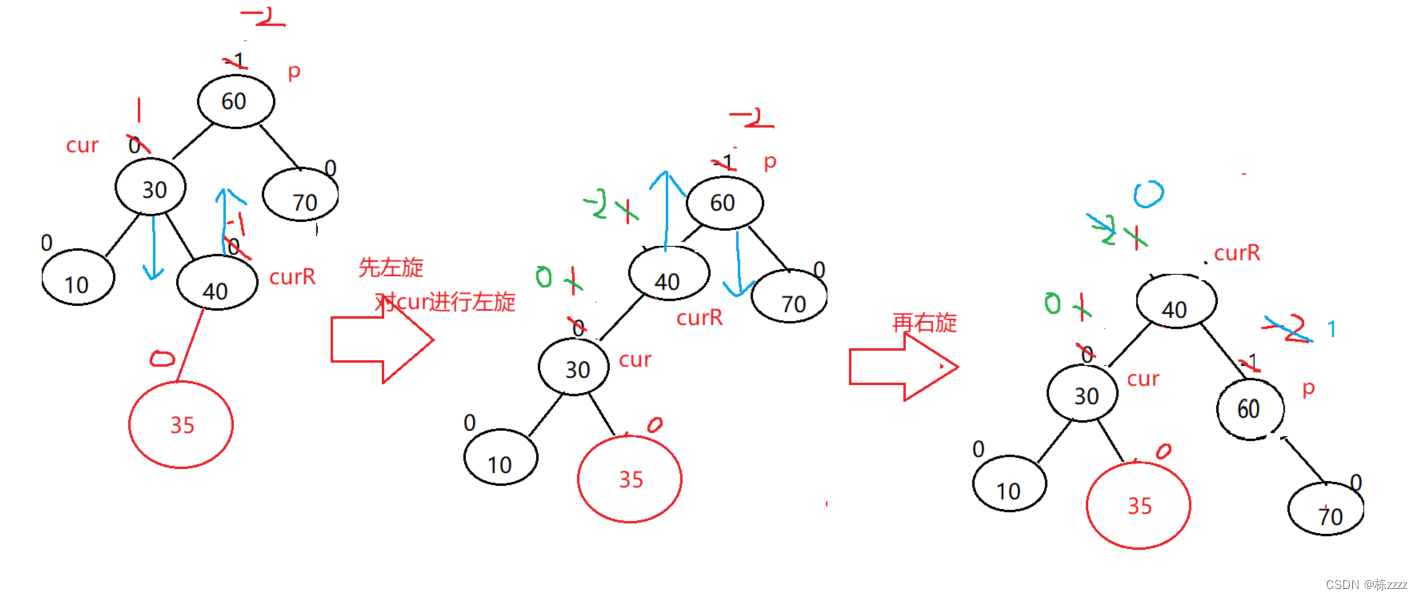
The left and right single spins have been introduced above , I won't go into details here ,
First left :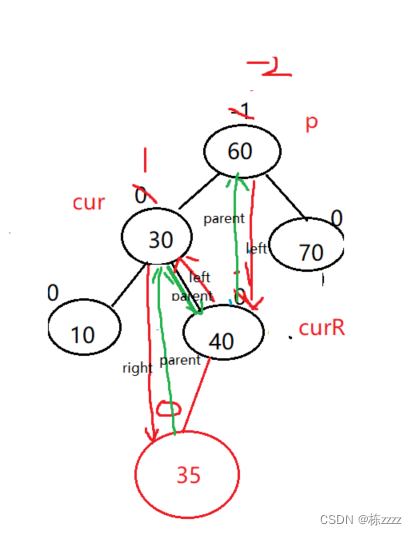
At this time, the modified balance factor is useless
Turn right again :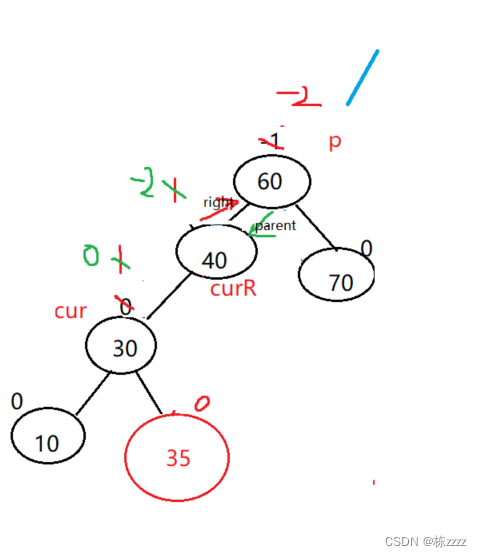
After two rotations, only Change the balance factor That's all right. ,
Through observation curR The equilibrium factor of , Will determine the balance factor of the last other nodes
The code is as follows :
private void rotateLR(TreeNode parent){
// Double left and right
TreeNode cur = parent.left;
TreeNode curR = cur.right;
// You need to see it now curR The equilibrium factor of , Then determine the balance factor of other nodes
int bf = curR.bf;
// Call left rotation first, then right rotation
rotateLeft(parent.left);
rotateRight(parent);
if(bf == -1){
curR.bf = 0;
cur.bf = 0;
parent.bf = 1;
}else if(bf == 1){
curR.bf = -1;
cur.bf = 0;
parent.bf = 0;
}
}
Such a left-right double rotation is over ~
1.4. Right left double rotation
At this time, the right tree is tall , You need to lower the height of the right tree (parent.bf = 2,cur.bf = -1):
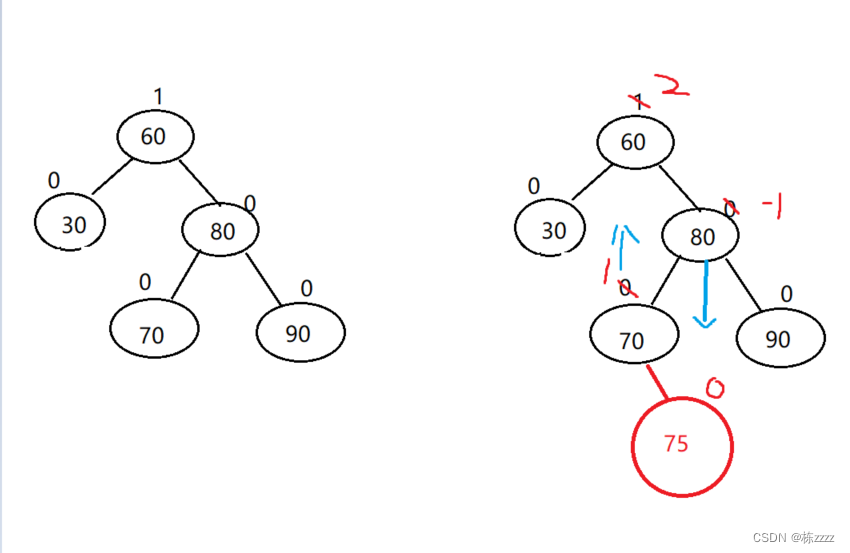
At this time, it is impossible to complete by single rotation , Need to pass through Two rotations To complete :
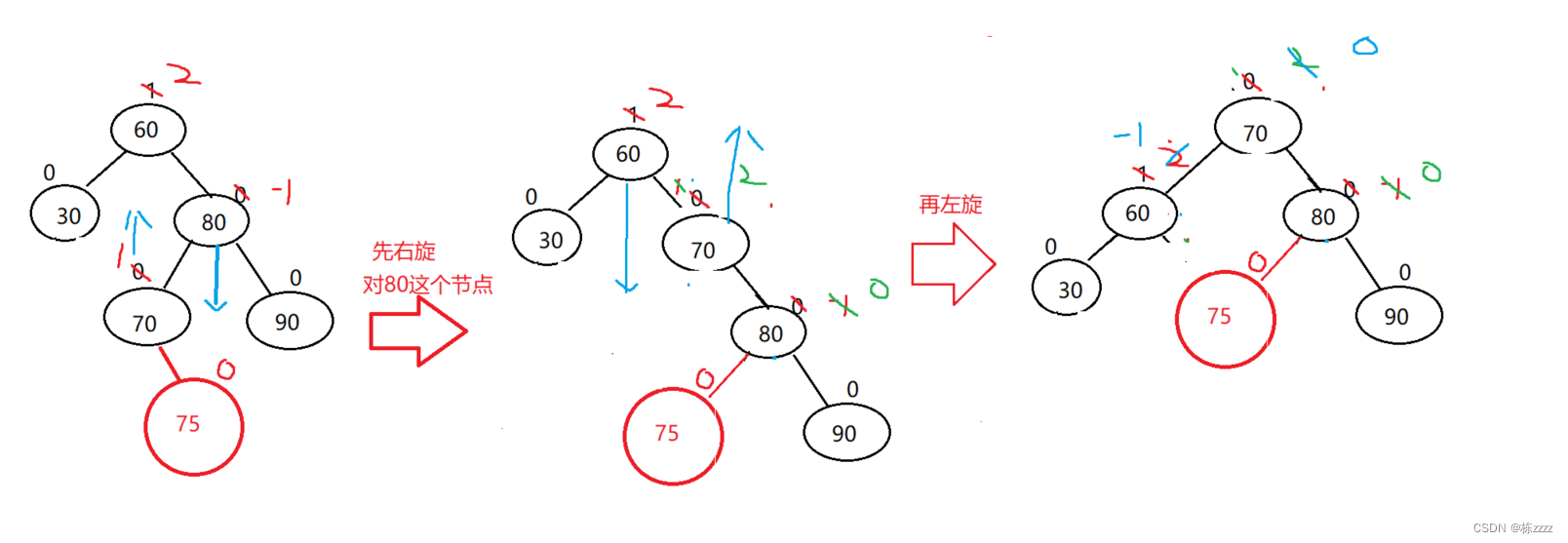
First right :
Turn left again :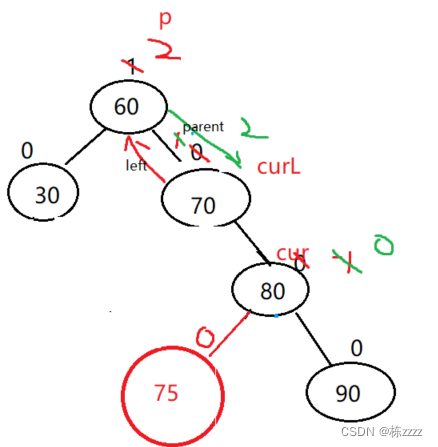
Through observation, it is found that the balance factor and curL It matters :
therefore
The code is as follows :
private void rotateRL(TreeNode parent) {
// Right left double rotation
TreeNode cur = parent.right;
TreeNode curL = cur.left;
// You need to see it now curL The equilibrium factor of , Then determine the balance factor of other nodes
int bf = curL.bf;
rotateRight(cur);
rotateLeft(parent);
if(bf == -1){
cur.bf = 1;
parent.bf = 0;
curL.bf = 0;
}else if(bf == 1){
parent.bf = -1;
curL.bf = 0;
cur.bf = 0;
}
}
2. Delete
The deletion is similar to the insertion above , because AVL The tree is also a binary search tree , Nodes can be deleted in the form of binary search tree , Then update the balance factor , Just different from deletion , Balance factor update after node deletion , In the worst case, always adjust to the position of the root node .
Specific steps :
- Find the node to delete
- Delete nodes according to the deletion rules of the search tree
- Update equilibrium factor , If there is an imbalance , Rotate .– The single spiral , Twin twist
I won't write complete code here !!
Come here ,AVL The introduction of the tree is over , We will continue to introduce red and black trees later !!!
边栏推荐
- app通用功能測試用例
- [boutique] Pinia Persistence Based on the plug-in Pinia plugin persist
- Computer reinstallation system teaching, one click fool operation, 80% of people have learned
- The "white paper on the panorama of the digital economy" has been released with great emphasis on the digitalization of insurance
- Knowledge * review
- Every year, 200 billion yuan is invested in the chip field, and "China chip" venture capital is booming
- 零代码高回报,如何用40套模板,能满足工作中95%的报表需求
- (LeetCode)两数之和
- 【精品】pinia 基于插件pinia-plugin-persist的 持久化
- openresty ngx_ Lua subrequest
猜你喜欢

每年 2000 亿投资进入芯片领域,「中国芯」创投正蓬勃
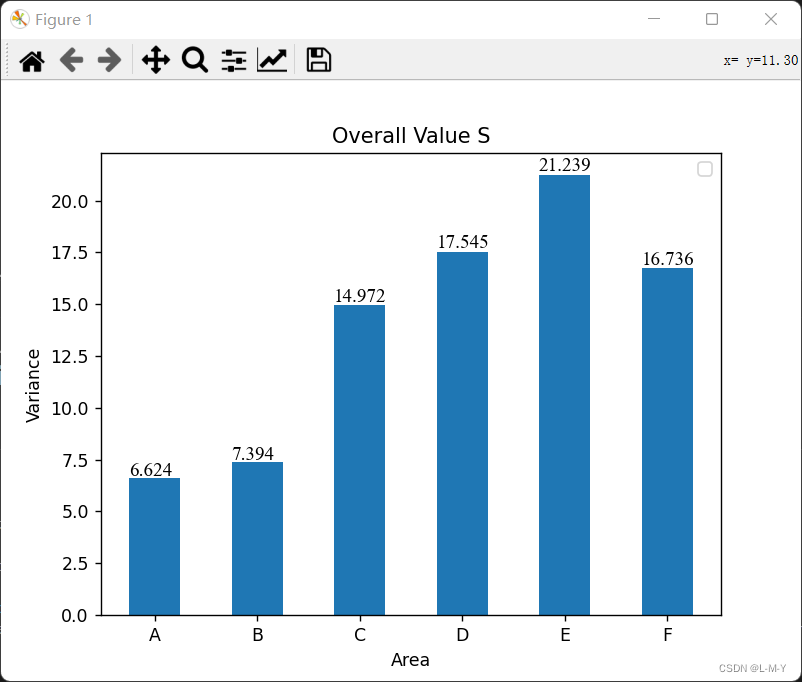
matplotlib画柱状图并添加数值到图中
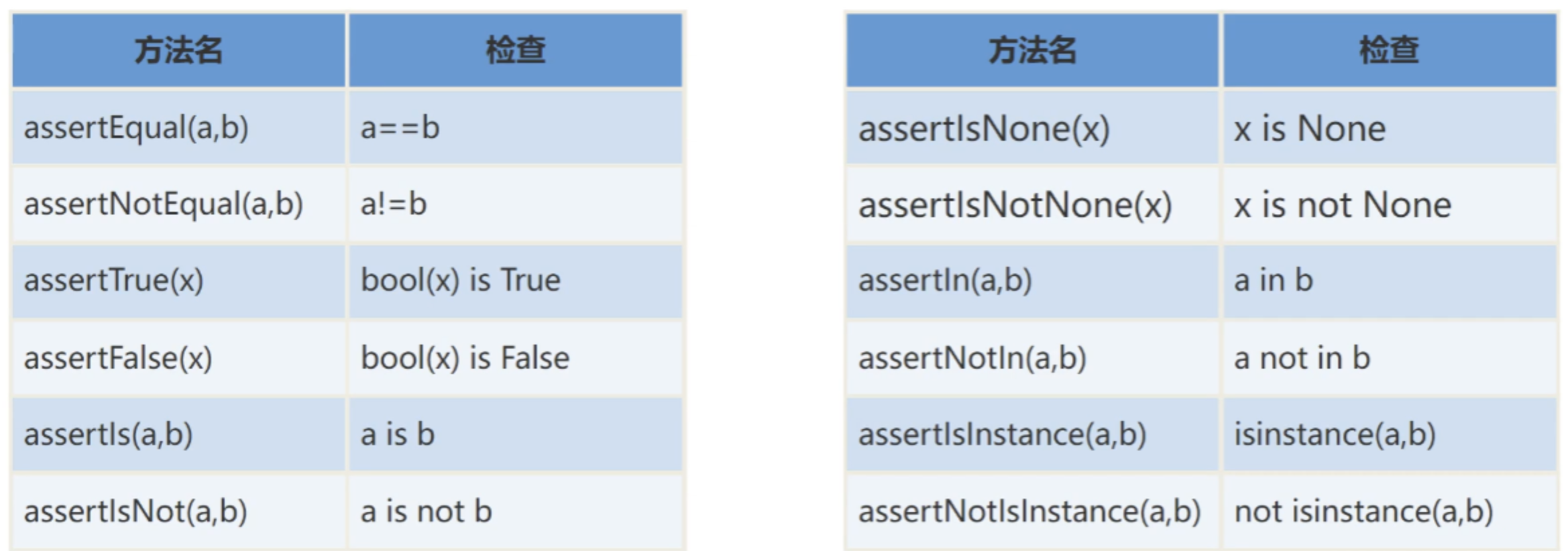
【自动化测试框架】关于unittest你需要知道的事

Knowledge * review

亚朵三顾 IPO

app通用功能測試用例
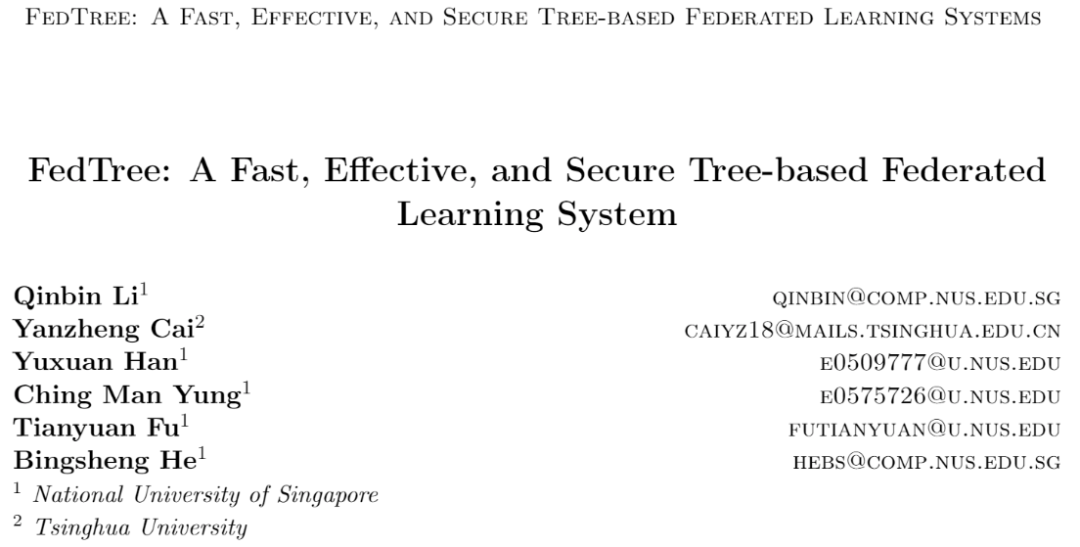
专为决策树打造,新加坡国立大学&清华大学联合提出快速安全的联邦学习新系统

Asset security issues or constraints on the development of the encryption industry, risk control + compliance has become the key to breaking the platform

MVC and MVVM

If the request URL contains jsessionid, the solution
随机推荐
Experiment 5: common automation libraries
Compile logisim
资产安全问题或制约加密行业发展 风控+合规成为平台破局关键
Every year, 200 billion yuan is invested in the chip field, and "China chip" venture capital is booming
Please help xampp to do sqlilab is a black
使用yum来安装PostgreSQL13.3数据库
Zero code and high return. How to use 40 sets of templates to meet 95% of the reporting needs in the work
编译logisim
17、 MySQL - high availability + read / write separation + gtid + semi synchronous master-slave replication cluster
[automated testing framework] what you need to know about unittest
Leetcode problem solving - 889 Construct binary tree according to preorder and postorder traversal
Pytest multi process / multi thread execution test case
Computer reinstallation system teaching, one click fool operation, 80% of people have learned
基础图表解读“东方甄选”爆火出圈数据
openresty ngx_ Lua subrequest
Experiment 6: installing eve-ng
Microsoft win11 is still "unsatisfactory". Multi user feedback will cause frequent MSI crashes
【自动化测试框架】关于unittest你需要知道的事
okcc呼叫中心的订单管理时怎么样的
【OFDM通信】基于深度学习的OFDM系统信号检测附matlab代码